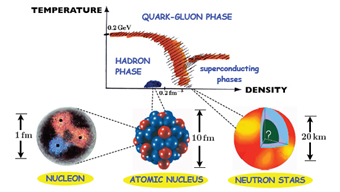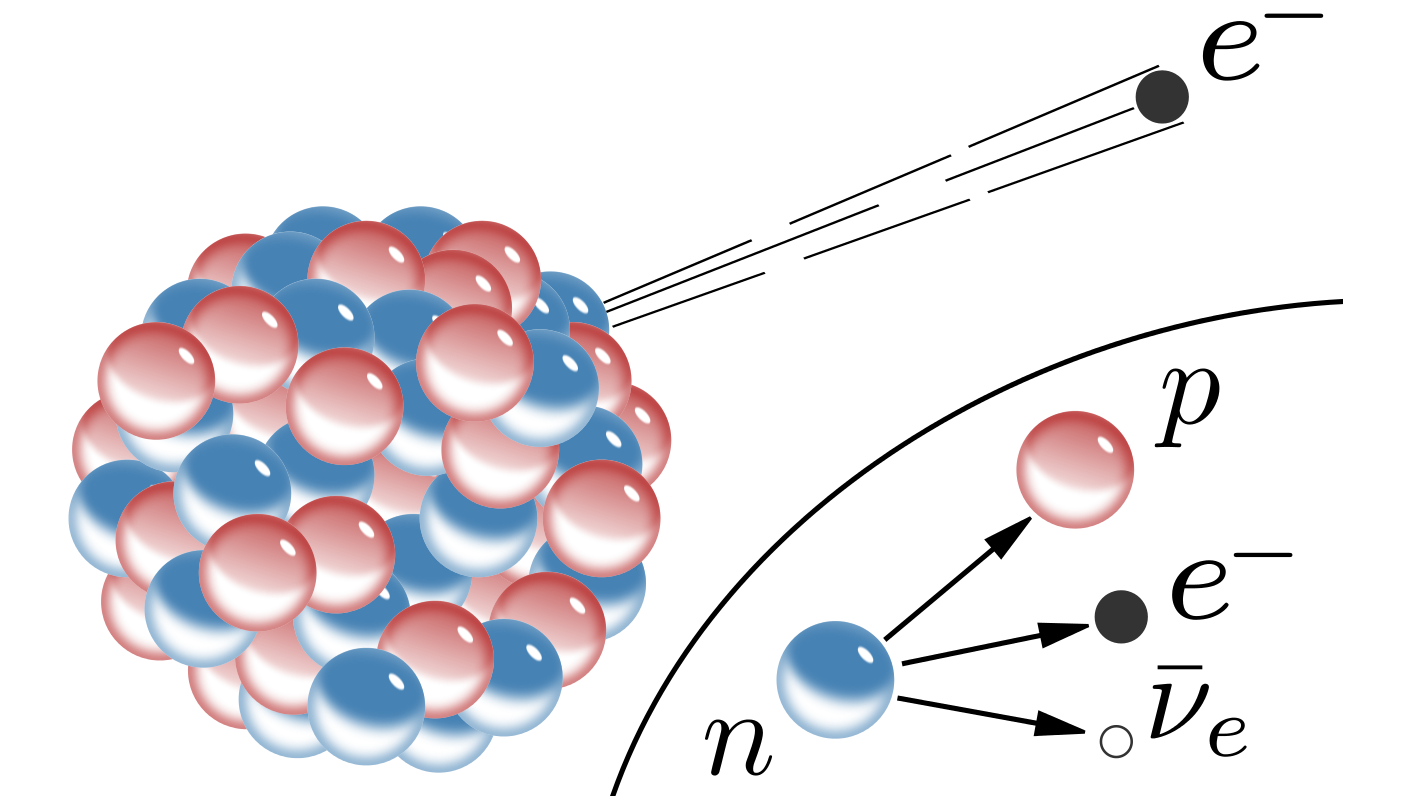Kern- und Hadronenphysik
 Hadronen wie Protonen und Neutronen bestehen aus Quarks, die über Gluonen wechselwirken.
Die starke Wechselwirkung, auch als Quanten-Chromodynamik (QCD) bekannt, wird durch den Austausch von Gluonen vermittelt.
Sie ist für die innere Struktur der Hadronen verantwortlich, die aus einem Quark und Anti-Quark (Mesonen) oder aus drei
Quarks (Baryonen) aufgebaut sind. Die QCD ist verantwortlich für die Lokalisierung ("confinement") der Quarks in diesen
zusammengesetzten Teilchen und für die offensichtliche Nicht-Existenz freier Quarks in der Natur. Während es möglich ist,
einfache störungstheoretische Berechnungen im Rahmen der QCD bei höheren Energien durchzuführen, ist die QCD
nicht-perturbativ bei niedrigen Energien, dem Bereich, der für die Eigenschaften der Hadronen relevant ist. Aus diesem
Grunde werden intensive experimentelle und theoretische Studien dieses nicht-perturbativen Regimes und der detaillierten
Eigenschaften der Hadronen durchgeführt, mit dem Ziel, die Natur der hadronischen Wechselwirkung besser zu verstehen. So
will man zum Beispiel verstehen wie sich der Spin des Protons durch die Spins und Drehimpulse seiner Konstituenten ergibt
oder warum die Masse des Protons ca. 1 GeV/c2 beträgt, während die drei Quarks, aus denen es besteht es gerade mal auf
etwa 15 MeV/c2 bringen.
Hadronen wie Protonen und Neutronen bestehen aus Quarks, die über Gluonen wechselwirken.
Die starke Wechselwirkung, auch als Quanten-Chromodynamik (QCD) bekannt, wird durch den Austausch von Gluonen vermittelt.
Sie ist für die innere Struktur der Hadronen verantwortlich, die aus einem Quark und Anti-Quark (Mesonen) oder aus drei
Quarks (Baryonen) aufgebaut sind. Die QCD ist verantwortlich für die Lokalisierung ("confinement") der Quarks in diesen
zusammengesetzten Teilchen und für die offensichtliche Nicht-Existenz freier Quarks in der Natur. Während es möglich ist,
einfache störungstheoretische Berechnungen im Rahmen der QCD bei höheren Energien durchzuführen, ist die QCD
nicht-perturbativ bei niedrigen Energien, dem Bereich, der für die Eigenschaften der Hadronen relevant ist. Aus diesem
Grunde werden intensive experimentelle und theoretische Studien dieses nicht-perturbativen Regimes und der detaillierten
Eigenschaften der Hadronen durchgeführt, mit dem Ziel, die Natur der hadronischen Wechselwirkung besser zu verstehen. So
will man zum Beispiel verstehen wie sich der Spin des Protons durch die Spins und Drehimpulse seiner Konstituenten ergibt
oder warum die Masse des Protons ca. 1 GeV/c2 beträgt, während die drei Quarks, aus denen es besteht es gerade mal auf
etwa 15 MeV/c2 bringen.
 CMS collision events, candidate Upsilons in heavy-ion collisions. Bild: CERN
Bevor sich das Universum so weit abgekühlt hatte, dass sich die Hadronen bilden konnten, muss eine spezielle Phase der
Materie existiert haben, in der Quarks und Gluonen nicht auf Mesonen und Baryonen lokalisiert ("confined") sind, das
sogenannte Quark-Gluon Plasma (QGP). Große experimentelle und theoretische Anstrengungen sind unternommen worden, um
diese Phase der Materie zu finden und um den Phasenübergang von der QGP zur hadronischen Materie zu studieren.
Untersuchungen der hadronischen Materie bei hohen Temperaturen und Dichten erlauben es, die Eigenschaften der
hadronischen Wechselwirkung und den Einfluss dieser Wechselwirkung auf das umgebende Medium zu studieren.
CMS collision events, candidate Upsilons in heavy-ion collisions. Bild: CERN
Bevor sich das Universum so weit abgekühlt hatte, dass sich die Hadronen bilden konnten, muss eine spezielle Phase der
Materie existiert haben, in der Quarks und Gluonen nicht auf Mesonen und Baryonen lokalisiert ("confined") sind, das
sogenannte Quark-Gluon Plasma (QGP). Große experimentelle und theoretische Anstrengungen sind unternommen worden, um
diese Phase der Materie zu finden und um den Phasenübergang von der QGP zur hadronischen Materie zu studieren.
Untersuchungen der hadronischen Materie bei hohen Temperaturen und Dichten erlauben es, die Eigenschaften der
hadronischen Wechselwirkung und den Einfluss dieser Wechselwirkung auf das umgebende Medium zu studieren.
 Schematic diagram showing a typical internucleon potential. Various meson exchanges induce attractive interaction at long distances (~few fm), and there is a repulsive core at short distances (~1 fm) between nucleons. Bild: TUM.PH/Chung
Die Nukleonen, Neutronen und Protonen, sind die leichtesten Baryonen und sind die Bausteine der Atomkerne. Aufgrund
der Substruktur der Nukleonen unterscheidet sich die Wechselwirkung zwischen Nukleonen in Kernen und zwischen freien
Nukleonen. Daher kann man die Eigenschaften der Kerne nur mit Hilfe "effektiver Wechselwirkungen" beschreiben. Es ist
ein wesentliches Ziel der Niederenergie-Kernphysik, diese effektive Beschreibung der Kerne auf der Grundlage einer
fundamentalen Theorie zu verstehen, in der die Lücke zwischen der QCD und dieser effektiven Nukleon-Nukleon
Wechselwirkung geschlossen wird. Die heute aktuellen experimentellen und theoretischen Arbeiten in der modernen
Kernphysik haben zum Ziel, alle Komponenten der effektiven Wechselwirkungen zu verstehen. Um dieses Ziel zu erreichen,
studiert man Atomkerne unter extremen Bedingungen hinsichtlich Temperatur, Drehimpuls und Proton-zu-Neutronen-Verhältnis
(Isospin-Abhängigkeit). Neben Präzisionsexperimenten am MLL Tandembeschleuniger werden an neuartigen
Beschleunigeranlagen, die Strahlen kurzlebiger radioaktiver Ionen bereitstellen, die Isospin-Abhängigkeit der
Wechselwirkungen und die astrophysikalisch relevanten Reaktionen untersucht.
Schematic diagram showing a typical internucleon potential. Various meson exchanges induce attractive interaction at long distances (~few fm), and there is a repulsive core at short distances (~1 fm) between nucleons. Bild: TUM.PH/Chung
Die Nukleonen, Neutronen und Protonen, sind die leichtesten Baryonen und sind die Bausteine der Atomkerne. Aufgrund
der Substruktur der Nukleonen unterscheidet sich die Wechselwirkung zwischen Nukleonen in Kernen und zwischen freien
Nukleonen. Daher kann man die Eigenschaften der Kerne nur mit Hilfe "effektiver Wechselwirkungen" beschreiben. Es ist
ein wesentliches Ziel der Niederenergie-Kernphysik, diese effektive Beschreibung der Kerne auf der Grundlage einer
fundamentalen Theorie zu verstehen, in der die Lücke zwischen der QCD und dieser effektiven Nukleon-Nukleon
Wechselwirkung geschlossen wird. Die heute aktuellen experimentellen und theoretischen Arbeiten in der modernen
Kernphysik haben zum Ziel, alle Komponenten der effektiven Wechselwirkungen zu verstehen. Um dieses Ziel zu erreichen,
studiert man Atomkerne unter extremen Bedingungen hinsichtlich Temperatur, Drehimpuls und Proton-zu-Neutronen-Verhältnis
(Isospin-Abhängigkeit). Neben Präzisionsexperimenten am MLL Tandembeschleuniger werden an neuartigen
Beschleunigeranlagen, die Strahlen kurzlebiger radioaktiver Ionen bereitstellen, die Isospin-Abhängigkeit der
Wechselwirkungen und die astrophysikalisch relevanten Reaktionen untersucht.
 Weak nuclear interaction / beta decay
Neben der starken Wechselwirkung ist die schwache Wechselwirkung wichtig, um die Eigenschaften der Kerne zu verstehen.
Die schwache Wechselwirkung beschreibt den Beta-Zerfall radioaktiver Atomkerne, zum Beispiel den Zerfall des
freien Neutrons. Sie bestimmt, zusammen mit den Kernreaktionen, den zeitlichen Ablauf der Brennprozesse in den Sternen,
wie z. B. in unserer Sonne, und sie ist wesentlich bei der Synthese der Elemente, aus denen unsere Welt besteht.
Viele der Kernreaktionen und Kerneigenschaften, die für astrophysikalische Prozesse wesentlich sind, kann man heute
im Laboratorium unter Nutzung stabiler oder radioaktiver Ionenstrahlen untersuchen.
Weak nuclear interaction / beta decay
Neben der starken Wechselwirkung ist die schwache Wechselwirkung wichtig, um die Eigenschaften der Kerne zu verstehen.
Die schwache Wechselwirkung beschreibt den Beta-Zerfall radioaktiver Atomkerne, zum Beispiel den Zerfall des
freien Neutrons. Sie bestimmt, zusammen mit den Kernreaktionen, den zeitlichen Ablauf der Brennprozesse in den Sternen,
wie z. B. in unserer Sonne, und sie ist wesentlich bei der Synthese der Elemente, aus denen unsere Welt besteht.
Viele der Kernreaktionen und Kerneigenschaften, die für astrophysikalische Prozesse wesentlich sind, kann man heute
im Laboratorium unter Nutzung stabiler oder radioaktiver Ionenstrahlen untersuchen.
Arbeitsgruppen: Brambilla - Bishop - Fabbietti - Kaiser - Paul